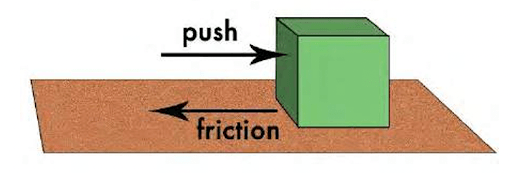If you rub your hands together really fast, they hurt and get hot. You’ve most likely been told a million times that this is because of friction. Some of the energy your muscles are generating to rub your hands together is being changed into heat energy by friction. If you push your hands together harder, they get hotter. What do you think would happen if you could make your hands rougher? Is there a way to measure the force of friction? This activity will use some fun dough, nuts, rubber bands, and sandpaper to find out.

Friction Fun
Experimenting with different surfaces and friction
What affects the force of friction?
This resource was originally published in PhysicsQuest 2018: Force.
What affects the force of friction?
- Rough grain sandpaper
- Fine grain sandpaper
- Four nuts
- Fun dough
- Rubber bands
- Ruler
- Tape
Take the rubber bands and hook the loop one through the other to attach them together.
Take one end of the rubber bands and loop it through one nut to attach the rubber bands to the nut.
Surround the nut with fun dough, making sure the rubber band is sticking out.
Tape the two strips of sandpaper next to each other on a table or desk.
Set down a ruler along the sandpaper strips.
Place the dough/nut combo on one end of the fine grain sandpaper strip.
Gently and steadily pull the rubber band until the dough/nut combo begins to move. Did the rubber band stretch before the dough and nut started to move?
Now do the same thing with the coarse grain sandpaper. Did the rubber band stretch more or less than with the fine grain sandpaper?
Unwrap the nut from the fun dough and attach the rubber band around all four nuts. Rewrap the four nuts in fun dough.
Repeat steps 1-3 with four nuts. What changed?
You are now going to do something very similar to the qualitative experiments on the previous page, only this time you will measure how much the rubber band stretches before the dough blob moves.
- Start with one nut and the fine grain strip of sandpaper.
- Very slowly stretch the rubber band until the blob starts moving. Record the distance the rubber band stretched before the blob moved. Repeat this four more times and take the average. Record that number in the table below.
- Repeat step 2 for two nuts, three nuts, and four nuts, with five tries each. For each try, keep track of the distance the rubber band stretched before the blob moved. Record the average in the table.
- Repeat steps 2 and 3 with the coarse grain sandpaper, recording the numbers in the table. Make sure to use units!

Which combination of sandpaper and nuts needed the most rubber band stretch to make the blob move?
Which required the least?
When the rubber band was pulled, it exerted a force on the blob. What force was pulling back on the blob?
How does the force of friction compare for each combination?
What different things does friction depend on? If you wanted to decrease the force of friction, what two things might you change?
Graph the rubber band stretch versus the number of nuts (stretch on the Y axis, number of nuts on the X axis) for both the fine grain and coarse grain sandpaper. Hint: use different colored pencils for each type of sandpaper. What does the graph look like?

Surfaces have something called a “coefficient of friction” which tells you how strong friction is. This coefficient is the force you measured by the amount of rubber band stretch divided by the weight — in this case the number of nuts. Can you find the coefficient of friction for both the fine grain and coarse grain sandpaper? Which one is bigger?
Do you think ice has a high or low coefficient of friction?
Do you think cardboard has a high or low coefficient of friction?
Do you think asphalt has a high or low coefficient of friction?
Do you think wood floors have a high or low coefficient of friction?